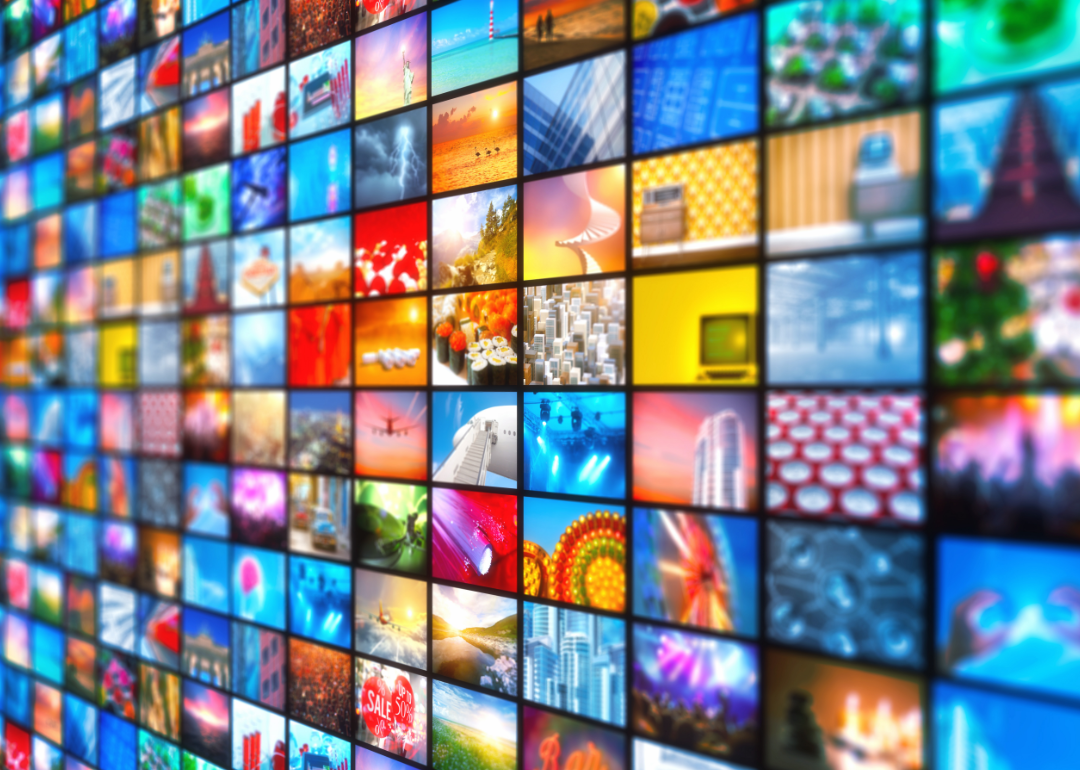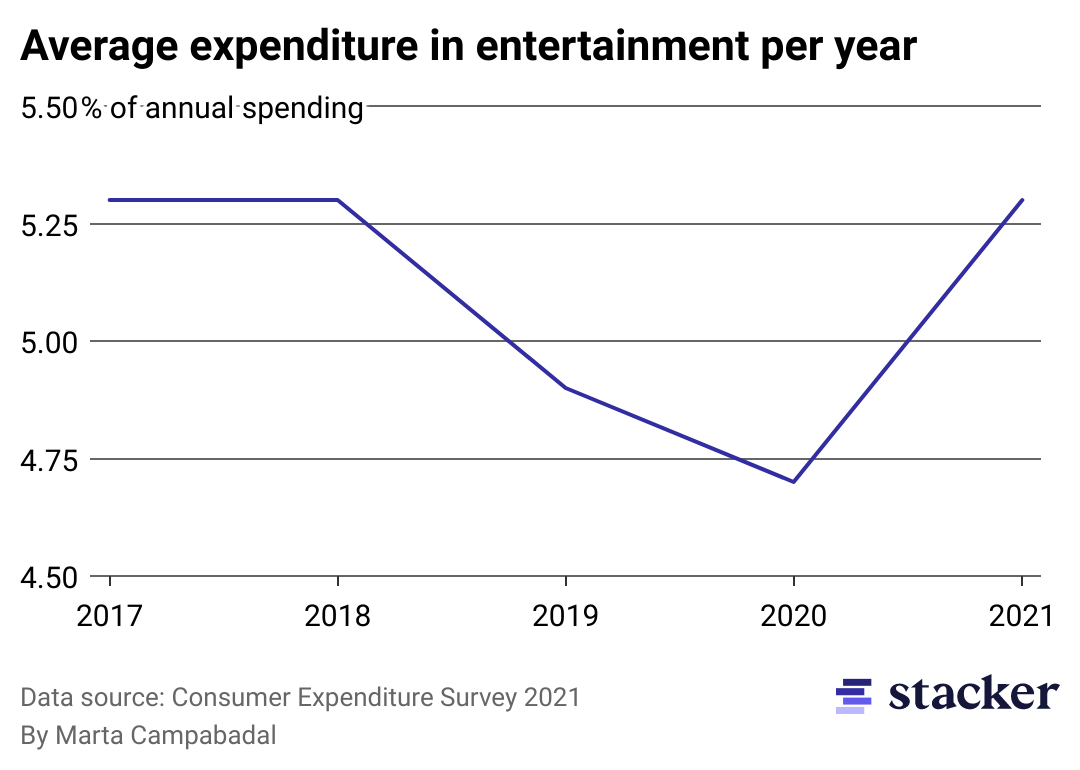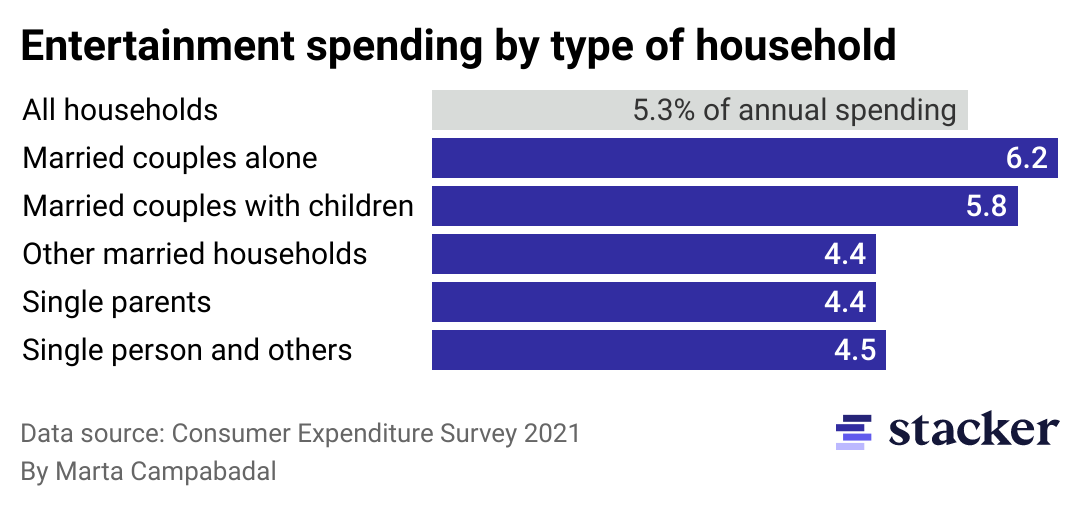How much do Americans spend on entertainment?

Canva
How much do Americans spend on entertainment?
Multiple media screens broadcasting video images.
From Beyoncé to Netflix to the Marvel Cinematic Universe, the United States has long provided the world with entertainment of all kinds. But what role does the average American have as a consumer of entertainment?
The act of consuming—enjoying music, movies, books, and other forms of entertainment—has certainly undergone drastic cultural changes in the last few decades. Add the onset of the pandemic, plus the consequent closure of theaters and music venues, and it’s hard to grasp what place entertainment still holds in an average consumer’s life.
Stacker looked into the Bureau of Labor Statistics Consumer Expenditure Surveys from 2017 to 2021 to find out how much Americans spend on entertainment and how that has changed over the past few years. To the BLS, a few types of expenses would fall under entertainment. These include fees and admissions (such as those to sports events or concerts, even memberships or recreation expenses on trips); entertainment equipment (like TVs and video games); pet expenses; and even purchasing campers and recreational vehicles. Some expenses, such as reading material, surprisingly fall outside of such entertainment. The Bureau provides a detailed list for those curious enough to get into the weeds.
COVID-19 has caused a drastic decrease in spending on entertainment and shifted how Americans spend their money. The surveys provide a helpful glimpse into just how entertainment spending has changed. What are the demographics of those spending the most and the least on entertainment? What categories of entertainment now dominate Americans’ wallets? How do these expenses compare with spending on housing, health care, and food? All of this information opens up a further conversation on the cultural significance of how entertainment affects the average American life.
![]()

Stacker // Marta Campabadal
People’s spending on entertainment took a dip in the first year of the pandemic but has since rebounded
Line chart showing the percentage of American’s budget dedicated to entertainment from 2017 to 2021.
The pandemic changed the way the world operated on a global and individual level. In the beginning, stay-at-home orders affected spending in retail and entertainment venues. As more people also work remotely, transportation expenses also decreased. By the fall of 2021, Deloitte reported that 84% of consumers were spending more time on online entertainment at home rather than going out. Deloitte also noted that streaming services enjoyed a 21% increase in subscribers in the first half of 2021.
As the country adapted to a new normal in 2021, entertainment expenditures rebounded, increasing by 22.7% in 2021. Entertainment expenses made up 5.3% of a household’s budget, the same level it had been in 2018. Entertainment spending was driven by a 60.6% increase in entertainment supplies and equipment, including buying and renting recreational vehicles. The second-largest bump in entertainment was in fees and admissions (for things like movies, plays, and theme parks) at 53.9%.

Canva
Pets, toys, hobbies, and buying playground equipment was a popular spending category
A dog resting amid a pile of stuffed toys.
The average spending on entertainment in 2021 was $3,568, of which $969 was used for pets, toys, hobbies, and playground equipment. It is apparent that more people were looking for creature comforts during the pandemic, as a Forbes Advisor survey of 2,000 adults revealed that 39% became pet owners in 2021 and 23% in 2022. More people also discovered or rekindled interests such as drawing, writing handwritten notes, and gardening.
Most telling, only an average of $654 was spent on fees and admissions. Before the pandemic, fees and admissions represented 28.5% of the total entertainment expenditure, while in 2021, it only represented 18.3%.

Stacker // Marta Campabadal
Married couples without children spent the most on entertainment
Column chart showing the percentage of budget expenditure on entertainment by household type.
In the pandemic, married couples without children spent the most on entertainment, using 6.2% of their household budget. A lack of child care expenses means an influx of joint discretionary income and leisure time to enjoy it. The survey did reveal that married couples with children weren’t too far behind, spending 5.8% of their household income on entertainment.

Canva
Entertainment ranks #6 on the list of where Americans spend most of their money
A young woman with popcorn watching sports on TV.
Interestingly, despite the radical changes caused by the pandemic, entertainment’s place in household spending has remained. From 2018 to 2021, the spending breakdown of households has remained remarkably stable. Housing expense always tops the list, making up more than 30% of annual spending. There was, however, a marked increase in share in 2020, when housing costs climbed to 34.9% share of household expenses, up from 32.8% the previous two years.
Transportation always comes second, followed by food, personal insurance and pensions, health care, and then entertainment. The spending categories’ seemingly immovable rankings just show the adage certainly holds—the more things change, the more things stay the same.